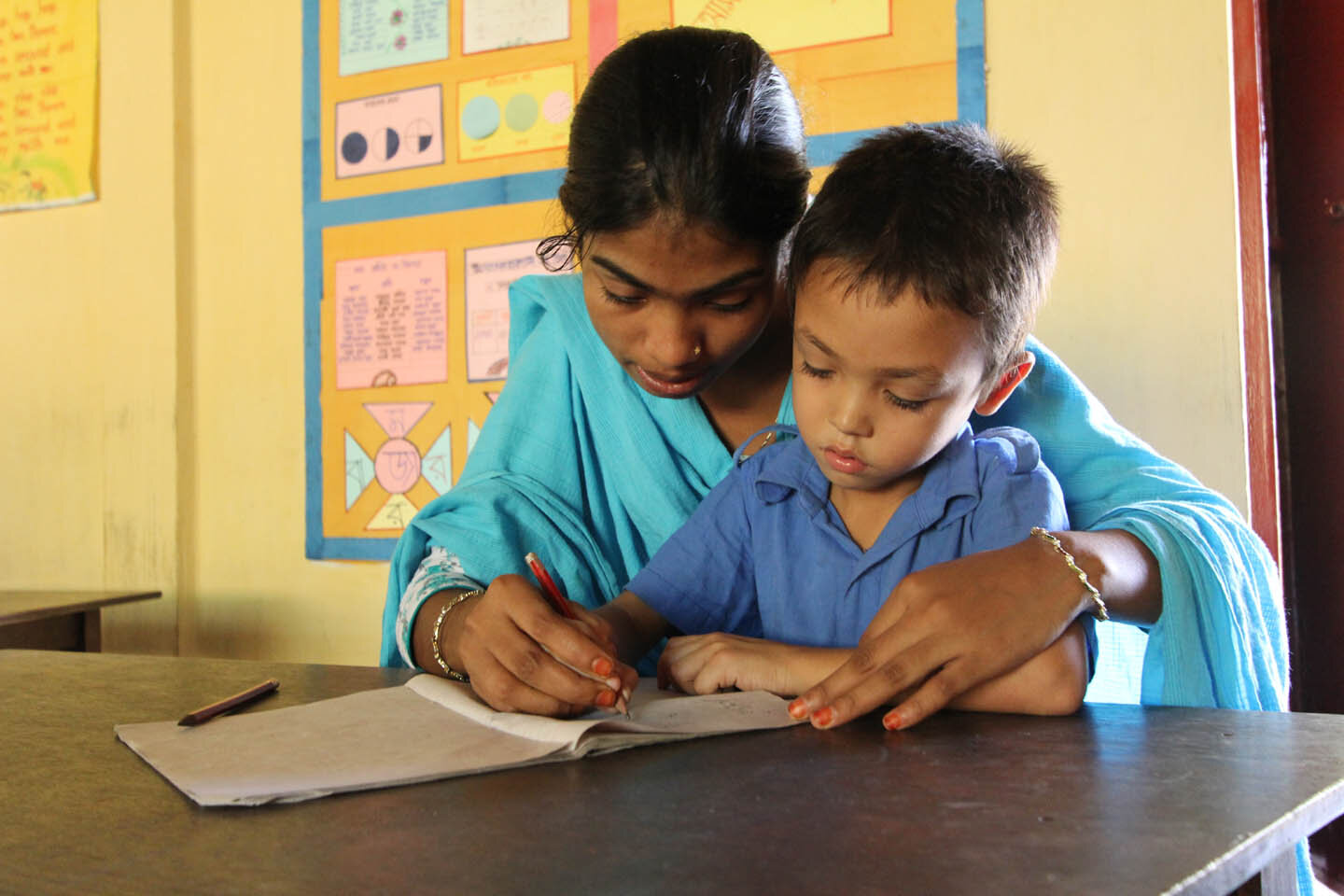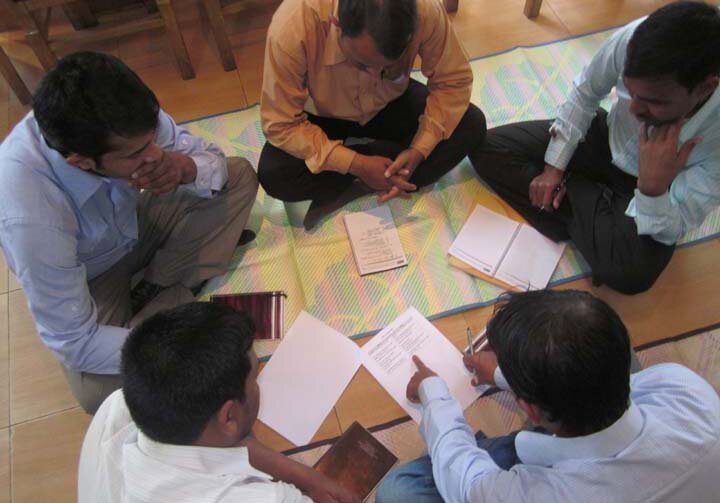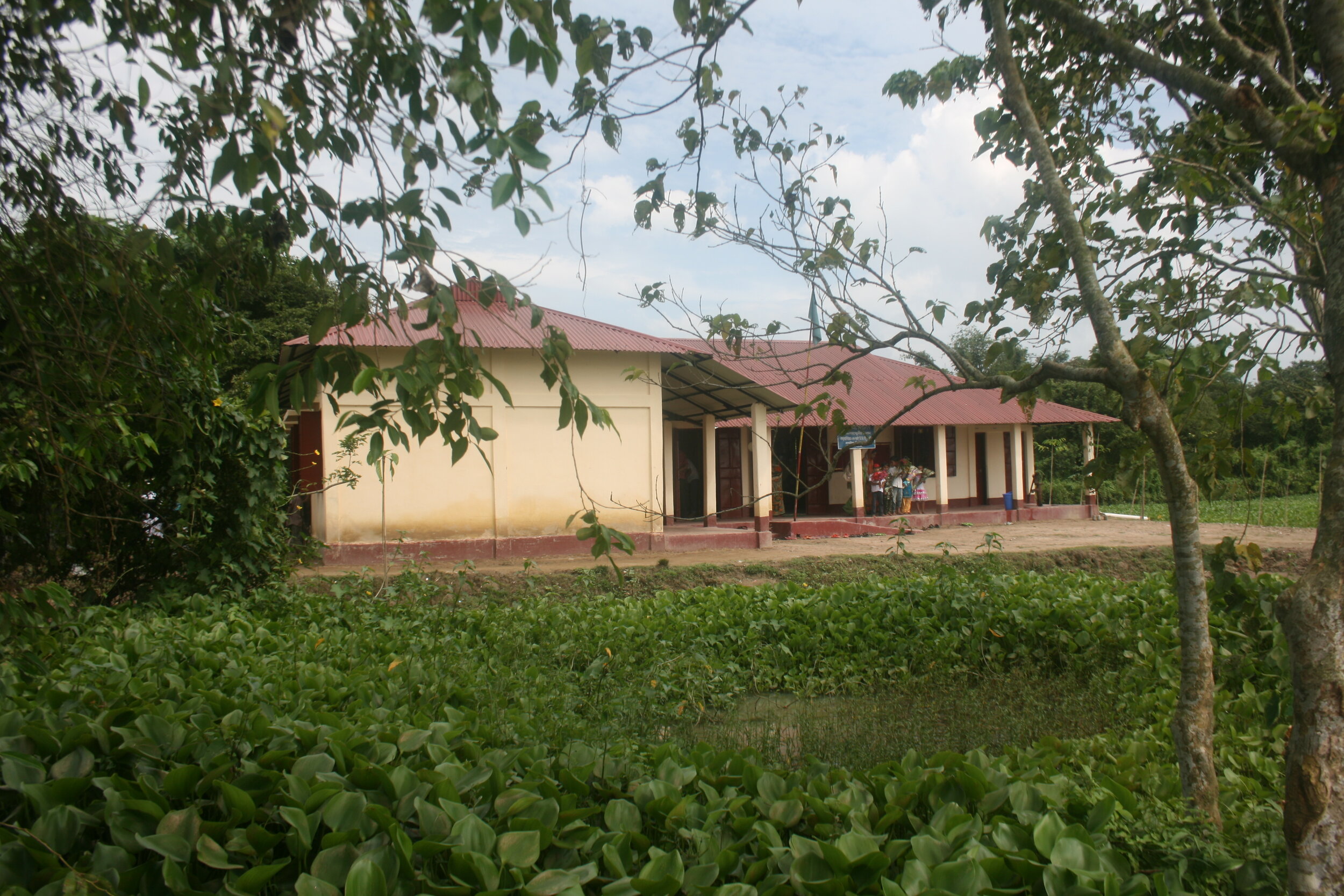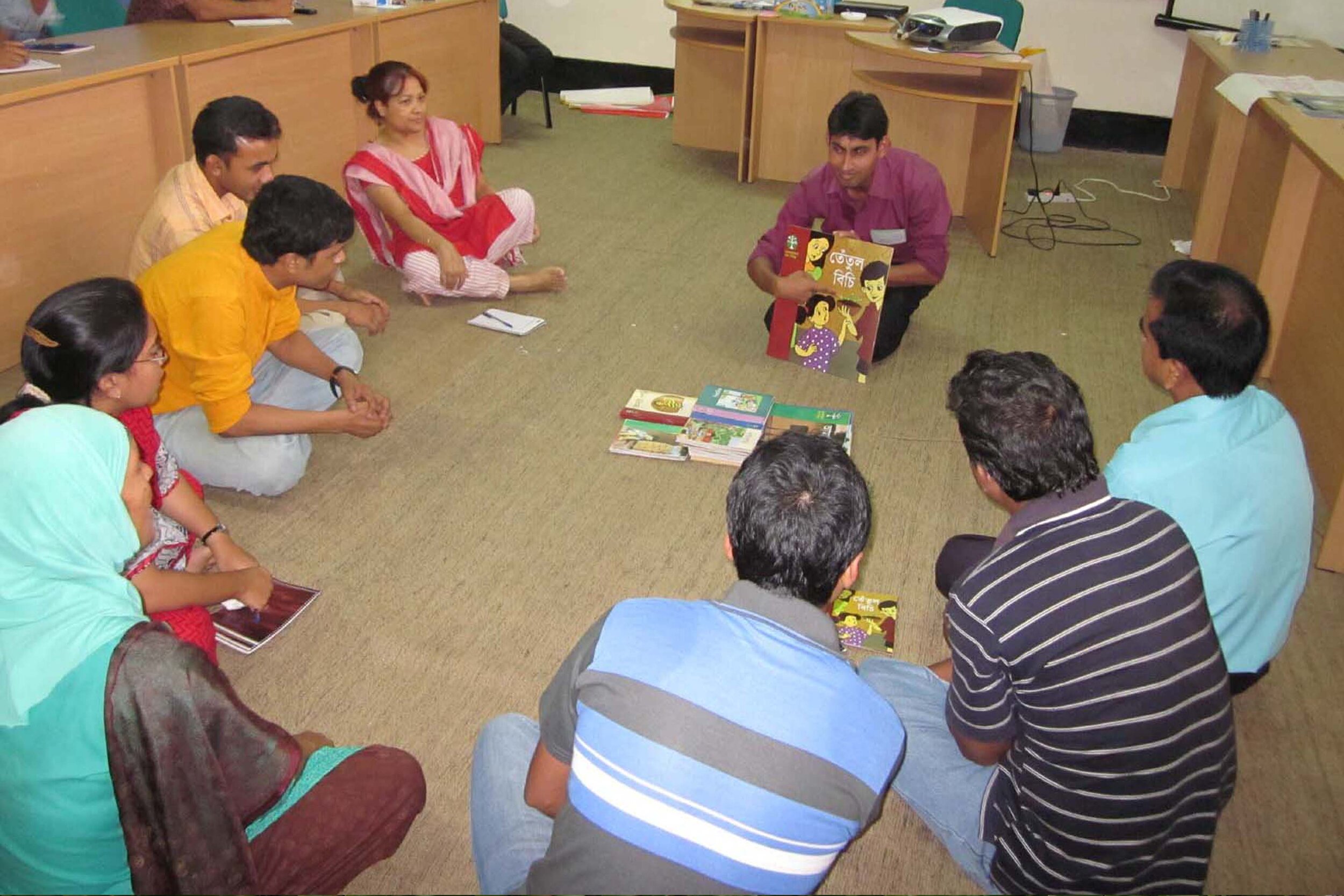
Child Development and Primary Education
over the last three decades the active learning methodology has evolved and developed into a full-fledged primary education program
Since its inception in 1981 FIVDB has developed, piloted and implemented functional literacy program for women, men, juvenile and young adults. In the mid 1980’s some of the adult learners established learning centers for their children in different villages. FIVDB supported these spontaneous community efforts with training and learning materials. From 1994 FIVDB started experimenting with active learning methodology in these learning centers. Over the last three decades the active learning methodology has evolved and developed into a full-fledged primary education program.
Active Learning and FIVDB
FIVDB aims to provide quality education in all of its schools through the use of the most effective teaching methods available. Currently, these methods are grouped under the title Active Learning. Active Learning is not one single prescribed manner of curriculum delivery; instead, it is composed of many varied techniques, all of which follow the principle that the key to successful learning is being fully engaged, being an active partner in discovery, rather than a passive receiver of knowledge.
Active Learning and the Teacher
The teacher, who implements active learning methodologies in the classroom, needs to be a skilled practitioner. A solid understanding of its principles and goals needs to be in place. Lessons making best use of active learning techniques require more careful planning and preparation than traditional techniques. The teacher must also become an active partner in delivering the curriculum, always engaged in considering the most effective way to convey knowledge and skills.
Active Learning and the Student
Students in an active learning environment will be more occupied than those in a traditional classroom. They will find themselves talking not only to the teacher, but to each other, as they work collaboratively in groups. They will be engaged in practical, hands on tasks. Problem solving skills will be required to gain access to knowledge. Facts are not simply spoon fed, but, through carefully planned activities, the students themselves will follow their own path to understanding. Once all this has taken place, the student is then asked to share their discoveries with each other, thus re-enforcing the learning.
Planning for Active Learning
The Active Learning Methodology is to be applied to all areas of the FIVDB school curriculum (Reading, Writing, Mathematics, English, Environmental Studies and Science). In planning for Active Learning, the teacher should consider firstly, what their lesson objective is, then secondly, how to deliver this in a way that encourages full participation by their students, not just physically, but mentally also. Songs, games, puzzles, group work, sharing ideas and investigating natural environment are all to be preferred to lecturing. In writing a lecture, the teacher considers what he or she will do and say. In planning for active learning, the teacher considers what his or her students will be doing.
Active Learning and Preferred Learning Styles
For many years now, it has been known that each of us, in any given situation, has our own preferred learning style. Perhaps we learn best through reading instructions; maybe we would prefer to talk it through with someone? Some people need drawings and diagrams to understand and for others, there is no substitute for doing.
Historically, teaching relied heavily on listening to the teacher and reading the textbook. This only suited those learners who enjoyed these learning styles, thus only those students experienced academic success. When these people went on to become teachers they only thought about the ways in which they themselves liked to learn, therefore the situation perpetuated itself and many, many people were denied the success they could have achieved.
Now it is recognized that there are as many ways to learn as there are students in the classroom. The teacher’s difficult task is to try to cater for all of these learning styles. Active Learning Techniques aim to do this by involving as many learning styles as possible. Listening, speaking, reading, writing, drawing, drama, music and song, art and craft provide the best possible opportunities for the teacher to reach all the students, whatever their preferred learning style.
Active Learning in Practice
Full participation in Active Learning is FIVDB’s ultimate goal and aspiration. Over the past 15 years, its curriculum and teachers have taken many steps towards this goal. The journey continues with ongoing developments and teacher training. Currently, the Shared and Guided Reading and Writing approach aims to bring greater participation through the teacher modeling reading and writing strategies and through more collaborative work between teacher and students in focus reading-writing sessions.
Students and their teacher currently visit the local area around their school, providing excellent inspiration for Environmental Studies work back in the classroom. A host of hands-on activities and group task are part of Science teaching.
Students as young as 5 and 6 are able to play maths games collaboratively, not only developing their number skills but also their ability to engage with each other socially.
In story writing, students provide the ideas in discussion with the teacher. Creativity is encouraged and students’ contributions are valued according to each individual’s ability.
Students share what they have learned and achieved each day, reciting stories and poems for their friends. Teachers involve the students in games, which reinforce the day’s learning, and each day ends with song, both in English and in Bangla.
Active Learning Methodology has continued to evolve since it was first introduced to FIVDB in 1994. FIVDB too, aims to evolve its own understanding of what it means to be an active learner, and will continue to assess, re-evaluate and innovate for the benefit of all involved.
The FIVDB Schools’ Curriculum
Schools
FIVDB schools cater for six years of primary education: pre-school / Shishu (age 5) to Class 5 (age 10). FIVDB follows the NCTB curriculum from class I to class V. The schools use the government school textbooks alongside supplementary learning materials designed to make the curriculum more child-centered. FIVDB has developed its own curriculum for the reception class with an emphasis on learning through games, group activities, visiting the natural environment and songs.
In the classroom a whole class teaching learning approach is followed. The teacher provides support to groups and individual students when it is needed. This whole class delivery method, where all students are engaged in the same subject yet bare split into groups, often to work collaboratively, forms the basis of all classes.
Teachers Guides
FIVDB has developed a large number of teacher’s guides. These guides are to be used alongside the existing government curriculum and contain suggestions as to how to make the activities in the text books more inline with the FIVDB Active Learning Philosophy. Guides are available for Bangla, Mathematics, Science, English and Social Studies in all classes.
Literacy – Bangla
The curriculum team has developed a new approach to teaching of reading and writing in reception, class 1 and class 2. Through vocabulary research, 45 high frequency words were selected. These high frequency words form the backbone of the reading books. However, it is not only development of reading books, which was unique, the system for teaching these books is also vastly different. In the classroom a newly developed Shared and Guided approach to teaching, reading and writing was introduced. These methods rely on teachers first modelling a process to children and then encouraging children to follow this model, supporting them at each step, until they become independent readers and writers. A total of 51 books have been developed as part of the reading scheme. These books range from text free to much longer, more challenging books whose story lines also teach other concepts such as magnetism and life cycles. All the books are colorfully illustrated. In order to assist the teachers in facilitating Shared and Guided reading-writing sessions 3 guide books have been developed.
The reading is further taught through the use of story books, a variety of which are supplied to each class depending on their needs and capabilities. FIVDB has published an assortment of 62 story books. Children’s enjoyment of books and reading is fostered and reading habit created to ensure the development of sustainable literacy skills. Children are also encouraged to develop their creative writing skill through the regular task of story writing.
Shared and Guided Reading and Writing:
A new introduction to FIVDB is the process of shared and guided reading and writing. Here children are firstly introduced to reading and writing through teacher demonstration. The teacher should model successful reading and writing thought processes. For example, the teacher explains about decoding a word, using phonetic knowledge or they talk through the process of trying to spell an unfamiliar word. This process of Metacognition shows children how to think for themselves when reading and writing; it promotes children’s own attempts instead of an over reliance on always asking the teacher what a word says or how to spell a word. In guided sessions, children are able to work at their own level and the teacher provides support based on each individual’s current ability. Instead of their being one common teaching process for the whole class, the teacher must adapt to the child, not the child adapting to the teacher. This enables both the weak and the strong pupil to be given the right level of challenge.
Speaking and Listening:
Children have the opportunity to share the work they have been doing with the rest of the class. They are encouraged to talk about what they have done, which means they must also listen to each other. Many rhymes are used both in Bangla and English; children have the chance to lead these rhymes for the rest of the class.
The emphases on group work means that children develop their communication skills whilst working alongside each other. They learn to listen and respect other children’s points of view.
Mathematics
Children begin their learning of mathematics in a very concrete way. They use dice, stones, number cards, number lines and sticks to develop early number concepts. Reception class children also follow a pre-number curriculum to teach them about relative sizes and patterns.
The National Curriculum for primary mathematics covers place value, the four operations, problem solving, fractions, measurements, shape. These topics, however, are covered in a very skill based way with children learning algorithms without first learning their underlying principles. FIVDB aims to promote concept learning in mathematics in addition to these skills.
In training, teachers have made a number of their own resources to support the development of number concepts in upper classes. Place value cards, hundreds tens and units cards, number fans, fraction rods and 3D shapes all aimed at providing children with concrete illustrations of concepts before moving on to more abstract work.
Science
The reception class EVS curriculum covers a number of familiar topics such as ‘My Family’, ‘My Body’, ‘Bangladesh flowers and fruits’, ‘Local Transport’ and ‘Water’. These are taught in a way that makes them relevant to children’s own lives. Teachers take students out to look at their environment to see which fruits and flowers grow naturally or which forms of transport are available in their area.
The same principles apply to the teaching of the National Curriculum Science Topics. Children should be actively engaged in practical work, not just reading about topics but engaging in experiments. Teachers have been trained to utilise local resources and easily available items in order to achieve this goal. The National Curriculum Topics of Water, Plants, Forces, Gases, Materials and The Solar System all have opportunities for practical activities, even the solar system can be modelled through role-play. A host of hands-on activities have been incorporated for practical understanding and fostering learning of scientific topics.
English
In their reception year, children learn English rhymes and simple vocabulary of objects found in the classroom. They also begin to learn to read and write English letters. FIVDB also promotes the use of phonics to help children learn to read in English.
Later children learn to talk about themselves and to read stories and other texts in English. They learn about grammar and punctuation rules. Teachers are trained to make their own resources such as flash cards for games in order to supplement the material in the text books. Children are involved in acting out texts to aid their understanding.
Social Studies
From reception to class 2, children are given the opportunity to visit local members of the community and the local area; guided by the teacher to gain a better understanding of the place in which they live. In the upper classes, children follow the government curriculum for social studies, with activities supplemented by FIVDB’s teacher’s guides.
Religious Studies
From class 3, children follow the government curriculum for religious studies. There are no teacher’s guides developed specifically for Religious studies by FIVDB but in training, teachers are taught the importance of valuing all religions and that this attitude must be passed on to the children they teach. Children should develop their own faiths as well as an appreciation for the beliefs of others.
Assessment
Children are regularly assessed through on-going formative assessment as well as periodic summative assessment. FIVDB provides assessment books, linked to the curriculum to aid teachers in knowing what and how to assess. FIVDB sees assessment as a crucial part of the teaching and learning process. Exams are set for all the schools twice a year. These results are then analysed and implications for further training and assistance to students and schools can be identified.
In the on-going assessment process the teachers regularly evaluate the level of competency a student achieves in Bangla, English, Maths, Science and Environmental studies. This helps teacher in identifying needs of the particular student and therefore, in providing required support to the students. For this purpose the teachers use assessment tools and sheets developed by the curriculum team. The supervisors also use the assessment results for providing support to the teacher. The training team on the other hand uses the assessment result in tailoring in service training course for the teachers.
Supervision System
The school supervisors visit a school once a week. One supervisor is responsible for four schools i.e. twelve teachers. Apart from checking the enrollment, attendance and physical facilities and environment of the school the school supervisors observe the teaching learning process and provide necessary academic support to the teachers.
The academic supervision includes:
a) Whether the teacher has been able to create a child friendly non-threatening environment in the classroom. b) How teacher model a particular lesson? c) Whether the teacher is able to interact with children. d) Whether the teachers are able to assign students level appropriate work in different subjects. e) Whether the students are involved in creative work, group tasks, raise questions, interact with each other, make presentations. f) Whether the teachers regularly assess students learning achievements using assessment tools and provide necessary support.
On the basis of the above observations the supervisors prepare a list and jointly plan with the teachers for strengthening teaching-learning in the classrooms. The supervisors provide hands-on training and mentoring support to the teachers so that the teachers are able to facilitate interactive learning in the classrooms.
Physical facility
FIVDB schools are established in un-served and underserved areas. The school is sited through participatory appraisal and mapping. The school building is built on a community donated land. The school house has three well lit and well ventilated classrooms and one resource room. The classrooms are furnished to facilitate interactive teaching learning process. The school has two toilets for girls and boys and a hand tube well for supply of potable water.
In the morning shift reception, class 1 and class 2 are held while class 3, 4 and 5 are held in the second shift in the early afternoon.
Primary Education Programme Training & Methodology
The PEP team aims to deliver its training in the same way as teachers should deliver their lessons in the classroom. As far as possible, all learning styles are catered for. Each training should provide something to interest any learner, whether they are Visual, Auditory or Kinaesthetic.
Visual
Visual aspects include the use of traditional methods such as overhead transparencies, drawings and diagrams. Recently, more modern presentation techniques have been included. PowerPoint slides with color and animation should help to make the content more attractive and memorable. Videos filmed in FIVDB schools illustrate the points being made in training, in a context which is relevant to the teachers and supervisors. They also provide good starting points for discussion.
Auditory
Clearly, the majority of the content is presented in spoken form, auditory learners don’t just like to listen, however, they enjoy talking about what they have heard. This is why training sessions involve a large amount of group work and discussion. Sharing relevant experience from schools is also encouraged. Often participants are given pens and poster paper with which to present their conclusions to the rest of the group. Songs are often used as a warm up before sessions, as well as being included as part of the training, especially in the Shishu curriculum.
Kinaesthetic
Kinaesthetic learners love the hands on approach. When new resources are introduced, participants use these resources in groups and may also make their own resources. Role play is a major part of any training, with participants given the opportunity to practice how they might use a particular resource or carry out science experiments in the classroom. During Initial Teacher Training, participants also visit schools for a multi-sensory experience of teaching.
Training
PEP delivers training to both its supervisors and its teachers, in order to continue professional development and to raise standards in schools.
Initial Teacher Training
Initial teacher training lasts one month and is provided to newly recruited teachers. Content focuses on pedagogy, what is understood by ALM (Active Learning Method), classroom organisation and subject based competencies such as reading, writing, mathematics and English. In addition, participants visit schools to observe teachers and to practice teaching. This constitutes 40% of the training.
In-service Training :
Reception – Class II
This is a one day training course and takes place each month in cluster centers; it is conducted by the supervisors. In this training, teachers are able to discuss their concerns as well as cover upcoming topics. Teachers can also share experiences with their peers.
In-service Training :
Class III - V
This takes place quarterly and lasts for three days. Training is held centrally and is residential. Topics covered include subject based teaching, to improve teachers own knowledge and how. the NCTB curriculum can be delivered whilst fulfilling the aim of ALM. Teachers have opportunities to try out new ideas and resources as well as make resources for use in their own classrooms.
Supervisor Basic Training
Supervisor Basic Training lasts for six days and is held centrally. The training covers areas such as basic education theory, for example Thinking Skills, pedagogy, subject based knowledge, teacher observation skills, assessment etc...
Supervisor In-service Training
Supervisor in-service training is held quarterly and lasts three days. The aim of the training is to improve supervisors subject based knowledge and how they will support teachers in delivering the curriculum. New initiatives may also be shared with supervisors as well as any new research which may be relevant to the teaching and learning in processes in school.
SMC (School Management Committee) Training
Each school has an 11-member School Management Committee (SMC), elected from the local community, which helps manage the schools. All members of the SMC, receive three days training on school management issues, their roles and responsibilities as well as being introduced to the principles of ALM. Some members may also be given refresher training, as and when needed.
Success Story
Md. Nahid Hasan, Son of Khukon Bepari and Jasna Begum, from Chowdhuripara, khadimnagar, Sylhet, a former student of Mukamergul Primary School, which is supported by FIVDB has admitted to Barishal Sher-e-Bangla Medical College after passing the MBBS admission test in 2024. Nahid had achieved GPA-5 in the primary completion exam in 2015 from Mukamergul Primary School. Following the same trend, he also passed the secondary and higher secondary exams with GPA-5.

























